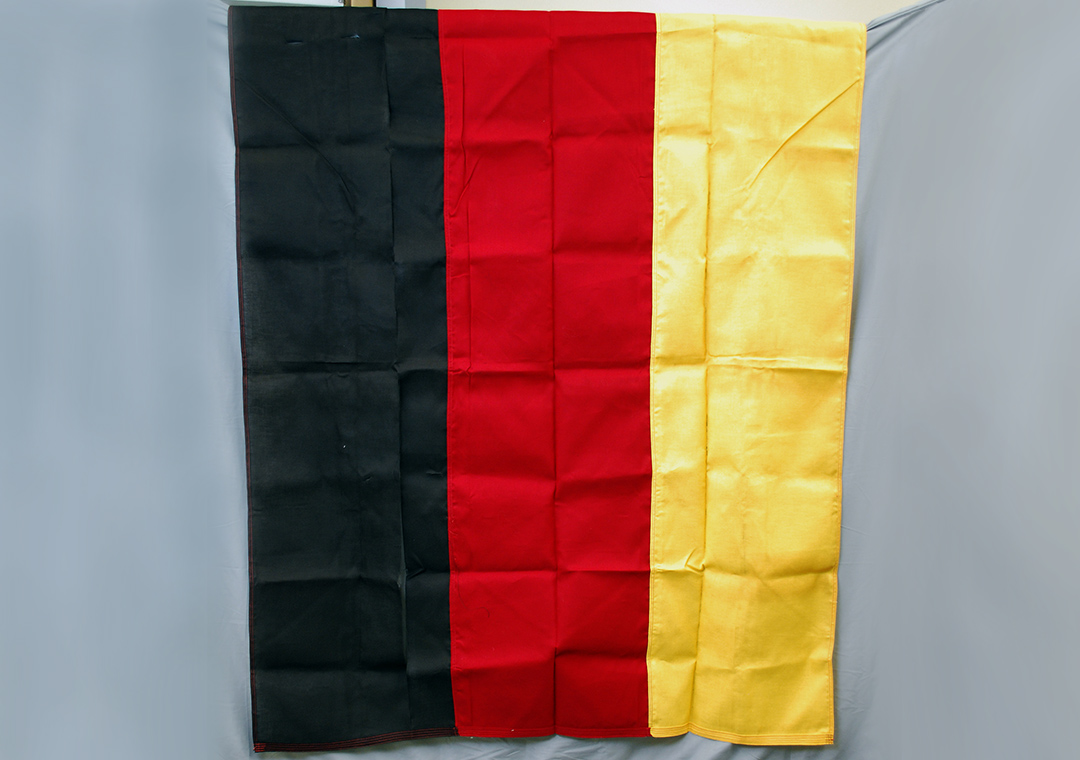This object is a replica of the National Flag of the Federal Republic Germany that was given to the UTSA Institute of Texan Cultures by the German Consulate in 1988. While the flag appears to be of a simple design, the history behind the design and colors used have a long history behind them!
When and where was the first German national flag created?
The modern national flag of Germany was declared in 1949, but the roots of the design and color go back centuries. The area that is now modern Germany was historically made up of many independent states, and these states were only loosely held together as part of the larger Holy Roman Empire. Germany was not unified into its own country until the Congress of Vienna in 1814. Often toted as the first flag of Germany, the forerunner of today’s German national flag was first flown at a rally known as the Hambach Festival in 1832 at Hambach Castle in Hambach, Germany.
What’s Hambach Castle, and why is it important?
The castle as it is seen today was not originally called Hambach Castle—it was called Kastenburg (or roughly translated in the Palatinate dialect as the Chestnut Castle) in honor of the chestnut forests surrounding the castle’s location in the Forest of the Palatinate. Initially constructed in the early 11th century, the castle’s early history is relatively unknown. Nevertheless, the castle was signed over to the Bishopric of Speyer in the early 12th century, where it remained as the bishop’s base of operations until 1797 (when it became property of the French government). By that time the castle had survived the Thirty Year’s War relatively intact, but had been more or less destroyed by French troops in the Palatinate War of the Succession. It was returned back to German ownership in 1816, to the Hambach territory in the Kingdom of Bavaria (hence the name).
The castle played an important part in the formation of German democracy at the 1832 Hambacher Fest, where the very first German national flag was flown.
Hambacher Fest and the First Flag
While the area of Hambach Castle passed back-and-forth between French and German control, the people of the area struggled under heavy taxes and extreme censorship. Democracy and freedom of speech were banned by the state, as were political gatherings such as protests or demonstrations. In order to circumvent these restrictions, a “Hambach Festival” was advertised in the area, and on May 27th, 1832 about 30,000 people from all social classes (including women) marched up to Hambach Castle. The Festival featured impassioned speeches that called for German national unity, popular sovereignty, more civil and political rights, and liberty. The first flags in Germany to utilize the colors of black, red, and gold— which would later become the national flag and national colors of Germany—were also flown.
What do the colors of the National German flag represent?
The colors of the modern German national flag feature prominently in German history. The earliest historical account of these colors being used on a flag came from the imperial coat of arms of the Holy Roman Empire. The Holy Roman Empire was a vast, German-majority and multi-ethnic kingdom that dominated central Europe from 962 AD to the year 1806—that’s almost 1,000 years of power! The colors featured on the coat of arms were used to depict a black eagle with two heads, with red talons on a golden background, and it was said that these colors were chosen to reflect the power and influence of the Holy Roman Empire.
For the modern National Flag of Germany, however, the three colors have very particular meanings. Black was said to symbolize the dignity and determination of the German people. Red was said to symbolize bravery, strength and valor. The color of gold historically represented wealth, power, and prestige. However, some stipulate that the colors represent a valiant group of volunteers who fought in the Napoleanic Wars. It’s no wonder then that this positive variation of the National German flag has appeared multiple times in Germany’s long history!
Variations of the German National Flag
The German National Flag known as the Bundesflagge (boon-dess-flah-geh) or Federal Flag made its first formal appearance in 1848 as the de facto flag of the German Confederation (1815- 1866) and the Prussian German Empire. The war flag or Seekriegsflagge (see-kreegs-flah-geh) during this time period incorporated a double-headed eagle reminiscent of the coat of arms from the Holy Roman Empire.
Overtaken by the black, white and red flag of the German Empire of Prussia, the Bundesflagge would not be seen again until the Weimar Republic formed in 1919. While the national flag and its color scheme was back in style, the Dienstflagge zu Land (deenst-flah-geh zoo land) or State Flag was the first to have the eagle emblem in the center of the flag from 1921 to the end of Weimar Republic in 1933.
After the fall of Adolph Hitler and the Third Reich at the end of World War II, Germany was divided between the Western Allied victors (Great Britain, France, and the United States) and the Soviet Union. The combined sections that were run by the Western powers became known as “Federal Republic of Germany” – or West Germany, and the side controlled by the Soviet Union became known as the “German Democratic Republic”— or East Germany. The national flag of East Germany looked very similar to the national flag of Germany that was adopted in 1949, but with a coat of arms in the center that featured communist symbolism such as a compass, hammer and golden wheat.
The flag of Western Germany (that was adopted in 1949) is the same flag that flies today over Germany today, now a symbol of German strength, history and reunification.
